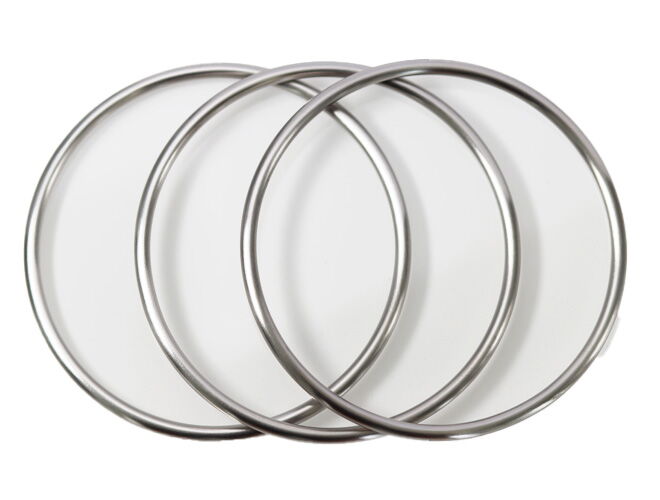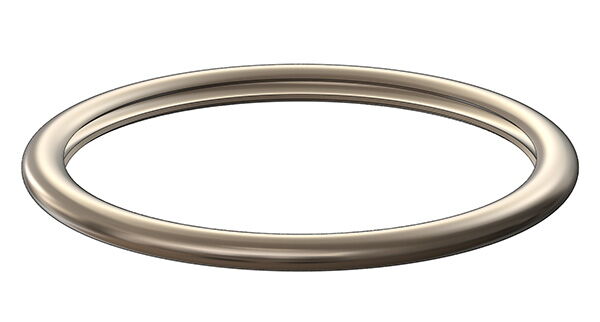In the many fields of modern industry, sealing technology is one of the key elements to ensure the safe and efficient operation of equipment. Whether it is petrochemical, nuclear industry, or aerospace, semiconductor manufacturing, reliable sealing components are needed to prevent media leakage and ensure the smooth progress of the production process. Today, let's take a deep look at two types of metal sealing rings: O-ring and C-ring. They play an important role in various complex working conditions with their unique structure and excellent performance.
In the complex working conditions of modern industry, the choice of sealing components is crucial. The O-ring, with its unique structure and outstanding performance, has become a reliable choice in high-temperature and high-pressure environments and can be regarded as the guardian in the field of sealing.

The O-ring is a new type of sealing component made of metal tube as the base material and coated with a flexible metal layer on the surface. Its base usually uses metal materials that are resistant to high temperature and high pressure, such as thin-walled steel pipes, stainless steel pipes, Monel alloy pipes, or Inconel alloy pipes, etc. These materials have excellent mechanical properties and corrosion resistance, which can withstand extreme working conditions. The flexible metal layer coated on the surface gives the sealing ring good flexibility and sealing performance, enabling it to maintain tight sealing contact in complex working conditions.
Extremely Low Leakage Rate and Anti-escape Function: The design of the O-ring allows it to maintain an extremely low leakage rate under various pressure and temperature conditions. This is due to its unique structure and material combination, which can form a tight contact on the sealing surface and effectively prevent the leakage of the medium. At the same time, it also has the anti-escape function. Even if there are pressure fluctuations or temperature changes, it can maintain stable sealing performance and prevent the accidental leakage of the medium.
Self-tightening and Pressure-enhanced Structure: The O-ring can be designed into self-tightening or pressure-enhanced types according to different working conditions. The self-tightening sealing ring can automatically adjust the sealing force under the action of internal pressure. As the pressure increases, the sealing effect will be further enhanced. The pressure-enhanced type, on the other hand, enhances the sealing performance by filling the sealing ring with gas or liquid and using its expansion force after being pressurized, which is especially suitable for high-pressure working conditions.
Simple and Compact Structure: The structure of the O-ring is very simple, with a compact sealing surface structure and easy installation. This makes it easy to apply in occasions with limited space, while also reducing installation costs and maintenance difficulties.
Full Metal Material Structure: Since it is made of full metal material, the O-ring has the characteristics of high temperature resistance, high pressure resistance, aging resistance, and high strength. It can work stably for a long time under extreme temperature and pressure conditions, is not easy to age or get damaged, and has a long service life.
Lower Sealing Load: The O-ring requires a smaller pre-tightening load for sealing, and the requirements for bolts and flanges are lower. This means that during the installation process, there is no need to apply too much pre-tightening force, which reduces the stress on flanges and bolts, lowers the risk of equipment damage, and makes the installation process simpler and faster.
The O-ring is widely used in special working conditions with high temperature, high pressure, high vacuum, ultra-low temperature, long life, extremely low leakage rate, and large pressure and temperature cycle requirements. For example, in the groove surface flanges or flat flanges of pressure vessels, thermal reactors, heat exchangers, gas turbines, ultra-high vacuum equipment, semiconductor equipment, and special valves, the O-ring can play an excellent sealing role. It is not only suitable for small-diameter equipment but also for large-diameter working occasions, with almost no limit on specifications and sizes, and can meet various industrial needs.
In the field of industrial sealing, in addition to the outstanding performance of the O-ring, the C-ring has brought new breakthroughs to sealing technology with its compact and efficient structural design. The C-ring, with its unique C-shaped cross-section and spring-enhanced design, has become an ideal choice for solving complex sealing problems.

The C-ring is a metal sealing ring product with a C-shaped cross-section, featuring a unique spring-enhanced design and using nickel-based alloy materials as the structural framework. This design gives the C-ring excellent resilience and sealing ability, enabling the combination of metal line sealing and constant stress sealing. Its structure consists of a spring, an intermediate layer, and a sealing layer. The spring part is made of materials that are resistant to high temperature and creep, ensuring stable elasticity in high-temperature environments; the intermediate layer has the characteristics of high temperature resistance and corrosion resistance, which can effectively protect the sealing layer; the sealing layer has flexibility and inertness, and can form a good sealing effect when in contact with the sealing surface.
Excellent Sealing Performance: The C-ring achieves sealing through the plastic properties of the metal "C" shape structure, which provides effective rebound load on the contact surface during compression. At the same time, the self-tightening pre-pressure of the opening surface of the sealing ring gives the sealing ring a self-tightening function. This structure enables the C-ring to maintain good sealing performance under various working conditions, especially suitable for complex environments such as high temperature, high pressure, high vacuum, and ultra-low temperature.
Good Resilience: The C-ring has excellent resilience, which can meet the requirements of temperature and pressure cycle working conditions. Under the conditions of temperature and pressure changes, it can automatically adjust the sealing force to maintain stable sealing effect and extend service life.
Full Metal Structure: Similar to the O-ring, the C-ring also adopts a full metal structure, which has the characteristics of high temperature resistance, high pressure resistance, aging resistance, and high strength. This enables it to work stably for a long time under extreme working conditions, is not easy to get damaged, and has high reliability.
Compact Sealing Structure: The sealing structure of the C-ring is very compact, suitable for small space and lightweight systems. Its design enables efficient sealing in limited space, especially suitable for equipment with strict space requirements.
Flexible Specifications and Sizes: The specifications and sizes of the C-ring are almost unlimited, and large-sized sealing parts can be made according to actual needs. This makes it able to meet the sealing requirements of various different equipment and has a broad application prospect.
Lower Sealing Load: The C-ring requires a smaller sealing load, and the requirements for bolts and flanges are low. This not only reduces the installation cost and maintenance difficulty of the equipment, but also reduces the damage risk to flanges and bolts caused by excessive pre-tightening force, and improves the safety and reliability of the equipment.
The C-ring is mainly used in special working conditions with high temperature, high pressure, high vacuum, ultra-low temperature, long life, extremely low leakage rate, and large pressure and temperature cycle requirements. It is widely used in the groove surface flanges or flat flanges of pressure vessels, heat exchangers, gas turbines, ultra-high vacuum equipment, semiconductor equipment, and special valves. In various mechanical equipment such as aerospace machinery, vacuum equipment, semiconductor-related machines, nuclear energy equipment, electronic equipment, mixers, melt spinning devices, hydraulic machines, etc., the C-ring can play an excellent sealing role and ensure the normal operation of the equipment.
In practical applications, the selection of the appropriate sealing ring needs to be determined according to the specific working conditions and equipment requirements. Although both O-rings and C-rings have excellent sealing performance and a wide range of applications, there are also some differences in structure and performance, and they are suitable for different occasions.
The O-ring, with its simple structure, stable sealing performance, and wide range of applications, is particularly suitable for occasions with high sealing performance requirements and complex working conditions. For example, in high-temperature and high-pressure equipment in the fields of petrochemical and nuclear industry, the O-ring can provide reliable sealing protection. The C-ring, on the other hand, with its compact structure, good resilience, and low space requirements, is more suitable for small space, lightweight systems, and equipment with low sealing load requirements. In fields such as aerospace and semiconductor manufacturing, where there are strict limitations on equipment weight and space, the C-ring is an ideal choice.
When selecting metal sealing rings, it is also necessary to consider factors such as the working temperature, pressure, medium properties, and flange type of the equipment. For example, if the equipment needs to run stably for a long time under high temperature and high pressure, then a sealing ring with high temperature and high pressure resistance should be selected; if the flange space of the equipment is small, then a sealing ring with a compact structure and low sealing load should be selected. In addition, it is also necessary to conduct corresponding tests and verifications according to the specific working conditions of the equipment to ensure that the selected sealing ring can meet the actual usage requirements.
Metal O-rings and C-rings, as important sealing components in modern industry, play an indispensable role in various complex working conditions with their unique structure and excellent performance. They can not only effectively prevent media leakage and ensure the safe operation of equipment, but also improve production efficiency and reduce maintenance costs. With the continuous development of industrial technology, the requirements for sealing technology are also getting higher and higher, and the application prospects of metal sealing rings will be more extensive.
In practical applications, the correct selection and use of metal sealing rings are very important. We need to choose the most suitable sealing solution according to the specific working conditions and equipment requirements, taking into account the performance characteristics, structural advantages, and test verification results of the sealing rings. At the same time, with the continuous progress of material science and manufacturing technology, the performance of metal sealing rings will also be continuously improved, providing more reliable sealing protection for industrial development.
In summary, metal sealing rings are an indispensable and important part of the industrial sealing field. With their excellent performance and wide range of applications, they provide a solid guarantee for the stable operation of modern industry. In future development, metal sealing rings will continue to play an important role and promote the continuous progress of industrial technology.
